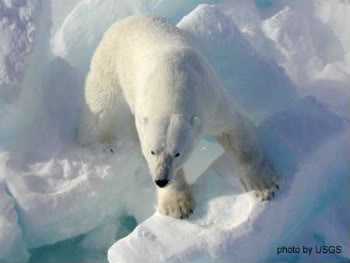In May 2008 the Bush Administration listed the polar bear under the Endangered Species Act (ESA). The listing immediately received allegations of being politically biased and not based on sound science. However, a new paper addresses the allegations point by point and concludes that the decision to add the polar bear under the ESA was not only scientifically sound, but right.
“The decision to list the polar bear as threatened was politically charged, and the scientific research on which it was based attracted some criticisms. Our new study shows that the critique is incorrect and based on misconceptions about climate models, the Arctic environment, polar bear biology, and statistical and mathematical methods,” said WHOI biologist Hal Caswell, an author of the paper, which was published in the journal Interfaces.
 The polar bear. Photo courtesy of the USGS. |
Caswell, a mathematical ecologist, was on the original team that analyzed the state of polar bear populations, especially as linked to the loss of sea ice in the Arctic. Caswell and the other members of the team, including scientists from the USGS, compared data of polar bears’ mortality and birth rates, life cycles, and habitat with changing sea ice patterns and other shifting conditions in the Arctic due to climate change. Using 10,000 simulations the team estimated the probability of future polar bear population’s undergoing decline. The team found a direct correlation between the amount of sea ice and polar bear population.
The Department of Interior relied heavily on the team’s work when listing the polar bear as endangered. Criticism, however, soon followed. Scott Armstrong, professor of marketing at the University of Pennsylvania, and his team published a widely-circulated paper that rebutted the findings by Caswell and his team. Armstrong’s team included a physicist and two economists, but no biologists or climatologists.
“We debated writing something short outlining why we don’t think their criticisms are valid,” said Caswell. “After going through their report, however, we decided we needed to do a rebuttal of this, and in the end, we went point by point to refute their criticism. We began by explaining why the sea ice habitat of polar bears is declining and showing how climate models, outputs from which we used as inputs to our analyses, are reliable for forecasting the future climate. Then we showed how each specific criticism of the Armstrong team was either wrong or misleading. Finally, we took a look at their principles of forecasting, and found they are too ambiguous and subjective to be used as a reliable basis for auditing scientific investigations.”
The rebuttal concludes that the criticism propounded by Armstrong does not stand up to scrutiny, and serves only as a distraction.
Caswell adds that he is not finished with polar bear. He will be apart of a new study looking at polar bear populations based on new data from the field.
Despite the fact that the major threat to polar bears is climate change, both the Bush and the Obama Administration have ruled that the listing of the polar bear under the ESA cannot be used to regulate greenhouse gases.
Related articles
U.S. lists the polar bear as threatened, but decision won’t affect emissions rules
(05/14/2008) The U.S. Interior Department has decided to list the polar bear as a threatened species due to declining sea ice cover in the Arctic. The decision comes a day before a court-imposed deadline to decide whether the polar bear should be protected under the Endangered Species Act.
Two-thirds of polar bears at risk of extinction by 2050
(09/07/2007) Two-thirds the world’s polar bears could be threatened with extinction by 2050 due to melting sea ice resulting from global warming, said U.S. government scientists Friday.
Global warming reduces polar bear survival rate
(11/15/2006) Polar bear survival rates have dropped significantly in the past 20 years, probably due to melting sea ice caused by higher temperatures, according to a study released this week.













